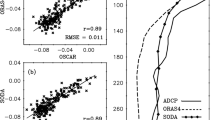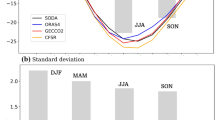Abstract
The low-frequency variability of the shallow meridional overturning circulation (MOC) in the South China Sea (SCS) is investigated using a Simple Ocean Data Assimilation (SODA) product for the period of 1900–2010. A dynamical decomposition method is used in which the MOC is decomposed into the Ekman, external mode, and vertical shear components. Results show that all the three dynamical components contribute to the formation of the seasonal and annual mean shallow MOC in the SCS. The shallow MOC in the SCS consists of two cells: a clockwise cell in the south and an anticlockwise cell in the north; the former is controlled by the Ekman flow and the latter is dominated by the external barotropic flow, with the contribution of the vertical shear being to reduce the magnitude of both cells. In addition, the strength of the MOC in the south is found to have a falling trend over the past century, due mainly to a weakening of the Luzon Strait transport (LST) that reduces the transport of the external component. Further analysis suggests that the weakening of the LST is closely related to a weakening of the westerly wind anomalies over the equatorial Pacific, which leads to a southward shift of the North Equatorial Current (NEC) bifurcation and thus a stronger transport of the Kuroshio east of Luzon.
Similar content being viewed by others
References
Baehr J, Hirschi J, Beismann J O, et al. 2004. Monitoring the meridional overturning circulation in the North Atlantic: a modelbased array design study. J Marine Res, 62(3): 283–312
Cabanes C, Lee T, Fu L L. 2008. Mechanisms of interannual variations of the meridional overturning circulation of the North Atlantic Ocean. J Phys Oceanogr, 38(2): 467–480
Dickson R R, Brown J. 1994. The production of North Atlantic deep water: sources, rates, and pathways. J Geophys Res, 99(C6): 12319–12341
Giese B S, Ray S. 2011. El Niño variability in simple ocean data assimilation (SODA), 1871–2008. J Geophys Res, 116(C2): C02024
Godfrey J S. 1989. A Sverdrup model of the depth-integrated flow for the World Ocean allowing for island circulations. Geophys Astrophys Fluid Dyn, 45(1–2): 89–112
Hirschi J, Marotzke J. 2007. Reconstructing the meridional overturning circulation from boundary densities and the zonal wind stress. J Phys Oceanogr, 37(3): 743–763
Kim Y Y, Qu Tangdong, Jensen T, et al. 2004. Seasonal and interannual variations of the North Equatorial Current bifurcation in a high-resolution OGCM. J Geophys Res, 109(C3): C03040
Lan Jian, Wang Yu, Cui Fengjuan, et al. 2015. Seasonal variation in the South China Sea deep circulation. J Geophy Res, 120(3): 1682–1690
Lan Jian, Zhang Ningning, Wang Yu. 2013. On the dynamics of the South China Sea deep circulation. J Geophys Res, 118(3): 1206–1210
Lee T, Marotzke J. 1998. Seasonal cycles of meridional overturning and heat transport of the Indian Ocean. J Phys Oceanogr, 28(5): 923–943
Liu Changjian, Du Yan, Zhang Qingrong, et al. 2008. Seasonal variation of subsurface and intermediate water masses in the South China Sea. Oceanologia et Limnologia Sinica (in Chinese), 39(1): 55–64
Liu Qinyu, Arata K, Su Jilan. 2008. Recent progress in studies of the South China Sea circulation. J Oceanogr, 64(5): 753–762
Liu W T, Xie Xiaosu. 1999. Spacebased observations of the seasonal changes of South Asian monsoons and oceanic responses. Geophys Res Lett, 26(10): 1473–1476
Metzger E J, Hurlburt H E. 1996. Coupled dynamics of the South China Sea, the Sulu Sea, and the Pacific Ocean. J Geophys Res, 101(C5): 12331–12352
Nan Feng, Xue Huijie, Chai Fei, et al. 2013. Weakening of the kuroshio intrusion into the South China Sea over the past two decades. J Climate, 26(20): 8097–8110
Nan Feng, Xue Huijie, Xiu Peng, et al. 2011. Oceanic eddy formation and propagation southwest of Taiwan. J Geophys Res, 116(C12): C12045
Qiu Bo, Chen Shuiming. 2010. Interannual-to-decadal variability in the bifurcation of the North Equatorial Current off the Philippines. J Phys Oceanogr, 40(11): 2525–2538
Qu Tangdong, Du Yan, Meyers G, et al. 2005. Connecting the tropical Pacific with Indian Ocean through South China Sea. Geophys Res Lett, 32(24): L24609
Qu Tangdong, Kim Y Y, Yaremchuk M, et al. 2004. Can luzon strait transport play a role in conveying the impact of ENSO to the South China Sea?. J Climate, 17(18): 3644–3657
Qu Tangdong, Mitsudera H, Yamagata T. 2000. Intrusion of the North Pacific waters into the South China Sea. Journal of Geophysical Research, 105(C3): 6415–6424
Schott F A, Dengler M, Schoenefeldt R. 2002. The shallow overturning circulation of the Indian Ocean. Prog Oceanogr, 53(1): 57–103
Shaw P T, Chao S Y. 1994. Surface circulation in the South China Sea. Deep Sea Res Part I, 41(11–12): 1663–1683
Sheremet V A. 2001. Hysteresis of a western boundary current leaping across a gap. J Phys Oceanogr, 31(5): 1247–1259
Shu Yeqiang, Xue Huijie, Wang Dongxiao, et al. 2014. Meridional overturning circulation in the South China Sea envisioned from the high-resolution global reanalysis data GLBa0.08. J Geophys Res, 119(5): 3012–3028
Sime L C, Stevens D P, Heywood K J, et al. 2006. A decomposition of the Atlantic Meridional Overturning. J Phys Oceanogr, 36(12): 2253–2270
Smith R D, Dukowicz J K, Malone R C. 1992. Parallel ocean general circulation modeling. Physica D: Nonlinear Phenomena, 60(1–4): 38–61
Thompson D M, Cole J E, Shen G T, et al. 2015. Early twentieth-century warming linked to tropical Pacific wind strength. Nature Geoscience, 8(2): 117–121
Tian Jiwei, Qu Tangdong. 2012. Advances in research on the deep South China Sea circulation. Chinese Science Bulletin, 57(24): 3115–3120
Tozuka T, Kagimoto T, Masumoto Y, et al. 2002. Simulated multiscale variations in the western Tropical Pacific: the mindanao dome revisited. J Phys Oceanogr, 32(5): 1338–1359
Vellinga M, Wood R A. 2002. Global climatic impacts of a collapse of the Atlantic thermohaline circulation. Climatic Change, 54(3): 251–267
Wang Dongxiao, Liu Qinyan, Huang Ruixin, et al. 2006. Interannual variability of the South China Sea throughflow inferred from wind data and an ocean data assimilation product. Geophys Res Lett, 33(14): L14605
Wang Dongxiao, Liu Xiongbin, Wang Wenzhi, et al. 2004. Simulation of meridional overturning in the upper layer of the South China Sea with an idealized bottom topography. Chinese Science Bulletin, 49(7): 740–746
Wyrtki K. 1961. Physical oceanography of the Southeast Asian waters. NAGA Rep, No 2. La Jolla California: The University of California Scripps Institution of Oceanography, 195
Xie Qiang, Xiao Jingen, Wang Dongxiao, et al. 2013. Analysis of deeplayer and bottom circulations in the South China Sea based on eight quasi-global ocean model outputs. Chinese Science Bulletin, 58(32): 4000–4011
Xie Shangping, Xie Qiang, Wang Dongxiao, et al. 2003. Summer upwelling in the South China Sea and its role in regional climate variations. Journal of Geophysical Research, 108 (C8): 3261
Yang Haiyuan, Wu Lixin. 2012. Trends of upper-layer circulation in the South China Sea during 1959–2008. Journal of Geophysical Research, 117(C8): C08037
Yu Kai, Qu Tangdong. 2013. Imprint of the pacific decadal oscillation on the South China Sea throughflow variability. Journal of Climate, 26(24): 9797–9805
Author information
Authors and Affiliations
Corresponding author
Additional information
Foundation item: The Strategic Priority Research Program of the Chinese Academy of Sciences under contract No. XDA11010302; the National Natural Science Foundation of China under contract No. 41376009; the Joint Program of Shandong Province and National Natural Science Foundation of China under contract No. U1406401.
Rights and permissions
About this article
Cite this article
Yang, Z., Luo, Y. Low-frequency variability of the shallow meridional overturning circulation in the South China Sea. Acta Oceanol. Sin. 35, 10–20 (2016). https://doi.org/10.1007/s13131-016-0826-9
Received:
Accepted:
Published:
Issue Date:
DOI: https://doi.org/10.1007/s13131-016-0826-9




